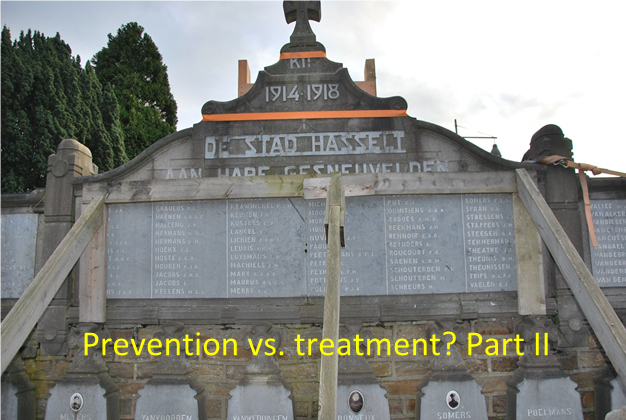Prevention vs. treatment? Part II
Prevention vs. treatment? The central role of programmed maintenance in cultural heritage management (Part II)
In this second part of my article, I would like to discuss in more detail the Programmed Maintenance approach, which I already introduced in the previous issue of the article “Prevention vs. treatment – part I”. Now, I will particularly focus on the use of scheduled maintenance as a preventive strategy, especially when this procedure is embedded in a regulatory framework with specific norms that foster its implementation.
The conservation project of the “Old Cemetery” of Hasselt in Belgium which I personally followed as a collaborator of the architecture firm Erik Martens & Partners (Maaseik, Belgium), is a particularly useful case-study to show a likely situation that could follow the lack of regular maintenance of historical buildings. Here, I will briefly introduce the regulatory framework that oversees compliance and safeguards the programmed maintenance of this type of projects in the Flemish region of Belgium.
It should be mentioned that the government of the autonomous Belgian Region of Flanders encourages and financially supports the programmed maintenance of its Cultural Heritage. This goal is achieved through a number of implementing tools that the Flemish Superintendence of Cultural Heritage –Agentschap Onroerend Erfgoed– can offer to the owners of listed buildings via its provincial offices.
In early 2018, at the moment of the project assignment undertake, the in-force regulation requested the submission of a draft management plan –beheersplan– covering the whole cemetery site. This document constituted the first step into the bureaucratic process and represented a strictly mandatory condition to gain access to the public funds to financially sustain the restoration works.
In general, the management plan -beheersplaan- is an implementing tool comprising a series of measures aimed at the maintenance, improvement and, eventually, re-establishment of the value and features of a cultural good through a long-term comprehensive view of a listed building (up to 24 years). This plan is made of several sections, among which the outline of the maintenance plan plays a central role. Once the management plan is approved, no further approval applications are required for starting the works and conducting the preventive activities included in the document. However, it is possible to apply for subsides for the scheduled works at any time, following a predefined procedure.
These norms underwent a slight update in early 2019, rendering the management plan only mandatory for a restricted list of cultural heritage categories, such as those under landscape-historical-cultural protection or archaeological sites and historic old towns, among others. Nonetheless, this document can be produced on a free-will basis and represents an added value in the hands of those willing to benefit from its advantages.
Furthermore, a novel preventive tool was recently introduced. It is in fact possible to benefit from additional funds, totaling 10%, if evidence can be provided about compliance with a proper maintenance behavior over the previous six years. These grants can be added to the basic subsidy, thus increasing the total percentage of financial support. In addition, a series of activities that fall within the category of regular maintenance are also eligible for funding, the list being freely available on the Flemish Superintendence website.
Prevention vs. treatment?
On the basis of what we have discussed so far, it can be concluded that the maintenance plan is a relatively straightforward, but extremely effective preventive tool in the management of Cultural Heritage. The actual plan is tailor-made by specialized professionals who are familiar with a building’s issues. By doing so, a list of necessary building monitoring activities is carefully established, along with a precise schedule defining the required timing to carry out specific preventive activities and controls, their appropriate frequency, realization methods and involved professionals.
Although a few basic monitoring activities can be easily performed by the building owner or by low-skilled workers, other actions require highly-skilled personnel. In this way, the practice of regular maintenance enables a true “early diagnosis” of potential issues or pathologies, which can be eventually accompanied by a prompt “healing” intervention to stop the progress of the building’s deterioration.
Beside the expected overall savings on extraordinary restoration works, the rationalization of the activities over time enables one to define an a priori yearly budget to be invested in individual programmed works, eventually gaining a better control of global expenses.
In conclusion, the Belgian experience teaches us that a maintenance plan is not exclusively linked to an ongoing restoration work. On the contrary, the choice to put into action a long-term preventive strategy can be taken at any time, irrespectively of the urgency to perform punctual interventions.
In fact, this type of approach entails the possibility to include in the list of planned activities also a series of interventions to be executed in the long-term, which are usually not considered as ordinary maintenance. Thanks to this long-term view, it is possible to design a neat and organized management of a building, virtually eliminating the risk of sudden damage and consequent need for extraordinary intervention.
After all, don’t we all agree that preventing is better than treating?
Did you like this article? Leave your comment ![]()









